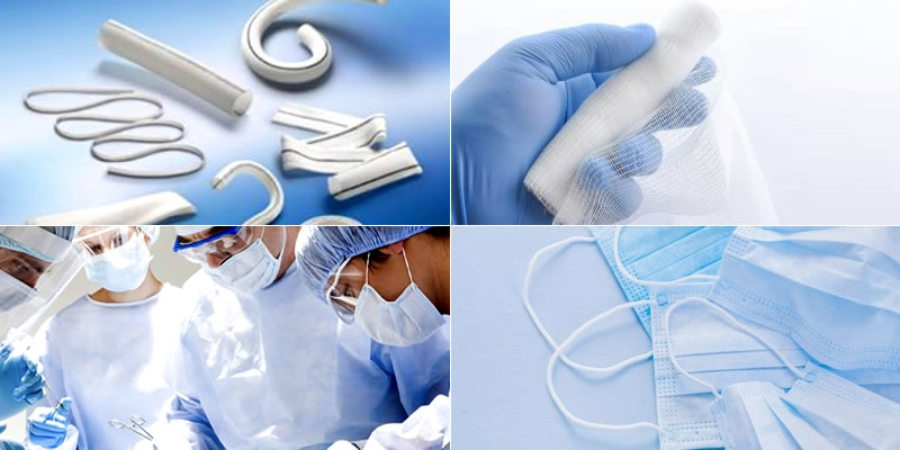Medical Textiles- Nurturing Future
The Textile industry is persistently achieving novel production practices to develop product quality in an environmentally friendly way. Textiles are an exceptional growing sector for primal clothing usage and a wide range of applications in the area of technical fields. In the global textile industry, Technical textiles are the rapidly growing sector with an extensive range of applications and also conjunction with other engineering fields such as medical textiles, agro textiles, protective textiles, sports textiles, geotextiles, automotive textiles, home textiles, mobile tech, and industrial textiles.
Medical textiles is a significant developing area in the technical textiles field. The different types of medical textile-based products outranged from wound healing materials to implantable devices are developed very technically for the prevention of healthcare-associated infections
Some of the medical textile products are wound dressings, incontinence diapers, surgical bandages, sanitary napkins, healthcare textiles, vascular grafts, sutures, heart valves, stents, artificial joints and artificial kidneys.
Classification of Medical Textiles
The products developed using fibres, yarns and fabrics are primarily used for medical applications. Some of the major products such as surgical gowns, face masks, bed covers, protective gloves etc are used in healthcare and hygienic practices. A group of products developed concerning the customer preferences, performance of the products and unit value.
(a) Surgical Textiles
Surgical textiles are of two major types, classified as implantable and nonimplantable materials. Implantable materials are cardiovascular stents, Implants made of soft tissue, vascular prostheses, ligaments made artificially, and organs. Non-implantable materials are wound dressings, bandages, plaster, face masks, surgical gowns, hand gloves, and aprons.
(b) Implantable Materials
Woven, knitted, nonwoven, braided, and embroidery products made from fibres, finer yarns, fabrics, and 3D-shaped fabrics are used for the development of implantable materials. The manmade materials used for implantable products such as polyamide, polytetrafluoroethylene (PTFE), polyester, polypropylene, and polyacrylonitrile. The properties required for implantable materials are biocompatible, porosity, non-toxic, drug release mechanism, and degradability to safeguard the human body and tissues
(c) Non-Implantable Materials
Non-implantable materials are commonly used for exterior applications in healthcare sectors. Both natural and manmade materials like cotton, polyester, polypropylene, silk, nylon, modal, and linen are used for Non-implantable products. Products developed from these materials are surgical gloves, aprons, bandages, wound dressing films, and face masks
(d) Extracorporeal Devices
The devices based on medical textiles that are used to support the functions of the kidney, lungs, liver, etc. are classified as extracorporeal devices. The fibre and fabric material aids the act and function of extracorporeal devices. Artificial kidneys are made with hollow hair-sized cellulose fibres or hollow polyester fibres. Artificial liver developed using hollow viscose; artificial lungs, and hearts are developed with hollow polypropylene, and PTFE or a hollow silicone membrane using fibre technology process are some examples of extracorporeal devices
(e) Hygiene Textiles
The development of antimicrobial textiles in recent years has helped to disseminate disease transmission through textile materials and improve the quality of life of the people. To protect the customers from contamination by microorganisms. It is very difficult to impart antimicrobial properties to the textile materials. Textile materials used in the wound healing area with antimicrobial activities will have some added therapeutic value to the textile materials. New technologies or new products developed by textile manufacturing companies related to medical textiles will have an important share in the global market
Most of the medical products are finished with chemicals that are toxic and most of the textile industry has continued to search for eco-friendly processes for developing medical textiles. A cumulative curiosity has been seen in the functionalization based on eco-friendly, and biodegradable substances.
Applications of Medical Textiles
In the technical textiles industry, one of the key aspects areas is medical textiles and every innovation continues to intensify in diversity in the field of medical textiles. Recent novelties include the application of chitosan-alginate fibres, ultrasonic bleached cotton fabrics, biodegradable materials, and spider silk in wound dressing materials, novel surgical sutures, and smart textiles. Medical textiles have enormous and various healthcare sector applications, such as biologically suited implants soft tissues, and prosthetics. Grip bandages, and antibacterial wound dressings.
Textile Materials such as natural and synthetic fibres, mono and multi-filament yarns, woven fabrics, nonwoven fabrics, braided, Structural composites and knitted fabrics are used for medical textiles. Due to the disposable nature of nonwoven products used in large quantities, and the increasing growth of composite materials used in the area of wound management products. Coating and lamination techniques are used for the combination of textile materials with foam, films, and adhesives to form hollow composite structures for wound management and healthcare products.
Textile materials play a significant function in the emerging growth of medical and hygienic products. New textile materials such as fibre properties, weave structure and technological machinery updation were introduced in recent years to increase the value of medical textiles. The technology upgrade and new medical textile products will help patients to rectify their healthcare problems. To manufacture accurate hygienic products with high antimicrobial, antiviral, and hygienic protection that are highly precious in the field of functional medical textiles.
Source

